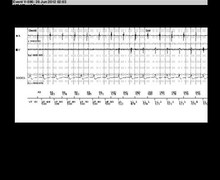Dual chamber discrimination, supraventricular arrhythmia, aberrancy
Tracing
Manufacturer Boston Scientific
Device ICD
Field Discrimination
N° 7
Patient
This 65-year-old man underwent implantation of a Teligen dual chamber defibrillator for primary prevention, in the context of severe ischemic cardiomyopathy. The QRS complex is narrow at rest. He presents with a complaint of palpitation.
Summary
Episode diagnosed in the VT zone with A>V and discrimination by Rhythm ID.

Graph and trace
Tracing
- rapid atrial activity (probable atrial tachycardia) with rapid and variable atrioventricular conduction, and alternation between VS, VT and VF cycles;
- 8 out of 10 cycles criterion fulfilled (V-Epsd);
- at the end of Duration, the treatment was withheld because of the presence of a) AFib (atrial rate > AFib Rate Threshold), and b) an unstable ventricular rhythm (stability value > 30-ms programmed threshold) with absence of correlation between vectors during the tachycardia and the reference vector (< 3 out of 10 cycles with correlated vector; all VF classified cycles were systematically classified as non-correlated). Further scrutiny of the tracing reveals variable morphologies and widening of the ventricular EGM after the shortest cycles on the high-voltage channel;
- continuation of the cycle-by-cycle analysis without revision of the diagnosis (Afib with aberrant atrioventricular conduction).
Other articles that may be of interest to you







Dual tachycardias and AFib with aberrant atrioventricular conduction are probably the most challenging tachycardias to discriminate for a dual chamber defibrillator. The V>A criterion is not decisive because, in both cases, the atrial rate is faster than the ventricular rate. Furthermore, in both cases, correlations between the vectors during tachycardia and the reference vector are absent. Had discrimination depended on this criterion only, inappropriate therapies would have been delivered for AFib with aberrant atrioventricular conduction. When the vectors analysis is combined with Stability and a search for Afib, Stability determines the diagnosis when a) the vectors are not correlated and b) the atrial rate is > AFib Rate Threshold. If the rhythm is stable, the device diagnoses a dual tachycardia and delivers the therapies; if, on the other hand, the rhythm is unstable, AFib with aberrant atrioventricular conduction is diagnosed and the therapies are inhibited.